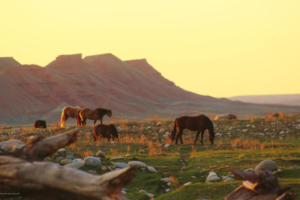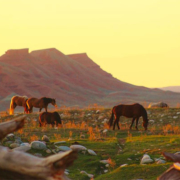
Although the pandemic brought unexpected changes for many, life on a ranch hasn’t changed much. Ranchers work outside, live in small communities and are usually far more self-sufficient than the general population.
“They’ve been practicing social distancing for 100 years,” ranch broker and LiveJacksonHole, LLC co-owner Chopper Grassell said. Ranching isn’t for everyone. It takes dedication to the land, years of experience and a profound stubbornness, traits that have come to be associated with the proverbial western cowboy. But, with the increasing opportunities for remote work, more and more urbanites are able to migrate to the country without making a career shift.
During this time of unprecedented isolation, open outdoor spaces can provide recreation, natural beauty and a place to socialize safely. As such, the allure of rural life has captured the minds and ambitions of homebuyers from New York to L.A.
Living remote
A year ago, city dwellers were already toying with the idea of moving to the country. “As of March 23, the seven-day average year-over-year change in pageviews of homes in rural areas and small towns were up 115% and 88% respectively,” Redfin, a national real estate brokerage, reported last April.
In addition to the benefits of living in less densely populated areas during a pandemic, a second factor has had a marked impact on American real estate. During the past year, remote work has been adopted by organizations from National Forest offices to Wall Street firms. According to Upwork’s December “Future of Workforce Pulse Report,” one in four Americans will work remotely in 2021.
The trend isn’t expected to end when the pandemic subsides. The study also projected that 36.2 million Americans will be working remotely by 2025, an 87% increase from pre-COVID levels.
Of course, not every remote worker will see their newfound freedom as an opportunity to buy a historic ranch estate in Wyoming or build a log cabin in the Alaskan wilderness. But, the bottom line is that remote work has allowed millions of Americans to consider where they want to live irrespective of their career.
According to a late 2020 Redfin survey of recent and prospective homebuyers, “one-third of respondents—34%—have already moved to a different city or area, and just as many—33%—would like to.”
What does it mean for ranches?
Chopper Grassell sells two kinds of ranches: agricultural production ranches and “recreational” ranches. While the market for the former tends to remain relatively unaffected by macroeconomic forces, the market for the latter has seen a boom during the pandemic.
“Things really changed during the year of COVID,” Grassell said. “All of the sudden people are saying, ‘Hey, I can’t do this any longer in Chicago or New York or San Francisco. I want to make a permanent move for tax reasons, cultural reasons or safety reasons. I want to be in a more rural area.’”
The evidence is in the numbers. Grassell and his partner, Richard Lewis, have been hard-pressed to find luxury properties for prospective buyers. “There are maybe tenfold more options for that recreational ranch last March as compared to now,” he said.
According to the Redfin survey, the wealthiest strata of Americans are also the most eager to move to a new area. 44% of recent and prospective homebuyers earning more than $150,000 a year have already moved to a different city or town in the past year.
The impact of this migration has yet to be seen, but it is sure to be complex. Although property values in aesthetic locations will most likely continue to rise, wealthy migrants may also bring economic value to rural communities.
Newcomers to the west are often drawn by the iconic heritage of self-sufficiency and a life lived close to nature. Right now, these ideas appeal to a broader range of Americans than ever before.
To find your own piece of the west, contact Chopper and Richard.
* View more from Redfin’s article “Interest in Rural Areas and Small Towns Spikes During the Coronavirus Outbreak” cited in this post.




